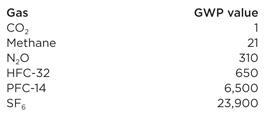What's new in production
EPA: Do you emit gas? If so, what kind and how much?
The Environmental Protection Agency’s “Mandatory Reporting of Greenhouse Gases Rule” has been booted about since it was first proposed in April 2009. Subpart W, called “Mandatory Reporting of Greenhouse Gases from Petroleum and Natural Gas Systems,” was first proposed a year later, and became final at the end of November 2010. Since then, it has undergone amendments and attempts at clarification, and comment periods followed by extensions to comment periods, but it’s basically still intact, and a done deal. Subpart W requires “petroleum and natural gas facilities that emit 25,000 metric tons or more of carbon dioxide (CO2) equivalent per year to report annual methane (CH4) and CO2 emissions from equipment leaks and venting, and emissions of CO2, CH4 and nitrous oxide (N2O) from gas flaring, and from onshore petroleum and natural gas production, stationary and portable combustion emissions, and combustion emissions from stationary equipment involved in natural gas distribution.” Understanding the rule is one thing, and explaining it is something else (I can do neither, really). But in late April, at the annual meeting of the Texas Alliance of Energy Producers, Greg Lorson, CEO of Total Energy & Environmental Co., did an impressive job of laying out the key points of the rule, and how producers can comply. With most media attention focused on CO2 in fossil fuel emissions, most outside the industry are surprised to find that CO2 contributes a [mere] [whopping] 60% of the “enhanced greenhouse gas effect.” The greenhouse gas (GHG) reporting rule actually regulates six kinds of gases, besides CO2: methane, nitrous oxide, perfluorocarbons (PFCs), hydrofluorocarbons (HFCs) and sulfur hexafluoride (SF6). It is interesting to compare the effect that the gases actually have. The shown table employs an invented unit of measure called the GWP, which stands for “global warming potential” (that may stick in some people’s collective craws, but that’s what it’s called). The GWP is the effect that a greenhouse gas has on the atmosphere, taking into account not only how much it reflects heat, but the time it spends doing so. CO2 is used as the basis, which makes up for the so-called low “radiative forcing” by a long atmospheric lifetime. So, what sorts of pollutant gases does the oil and gas industry sector actually emit? There are the volatile organic compounds (VOCs). Sources are leaks from storage tanks and glycol dehydrators, and venting from well completions and workovers. Additionally, VOCs are emitted by thousands of common products, like paints, cleaning supplies, bug spray, building materials, office equipment, such as copiers, correction fluids (they still make that?), and permanent markers. Other pollutants include particulates, sulfur dioxide (SO2 ) and NOx (nitric oxide and nitrogen dioxide), which are created during combustion, such as in drilling rig engines, turbines and heaters. Among the greenhouse gases, CO2 is emitted by engines and heaters, while methane is produced by some of the same sources as VOCs: storage tanks, leaks and venting. NO2 is not particularly a factor in oil and gas production, though it is emitted by all sorts of engines. It is more significantly produced by other sources (agriculture, landfills, rain forests, dentists), so the main GHGs of concern to the oil and gas industry are CO2 and methane. Who’s your tailor? In May 2010, EPA issued the final “GHG Tailoring Rule,” a policy that aimed to shield smaller sources of GHGs from strict Clean Air Act permitting requirements. The rule “tailors” the permitting programs to reduce the number of facilities that would be required to obtain New Source Review and Title V operating permits, based on GHG emissions. The threshold would cover power plants, refineries, large industrial plants and solid waste landfills, while exempting small stationary GHG sources like farms, schools and restaurants. Emissions are stated in CO2 equivalency (CO2e), so that each gas is expressed on a CO2 basis by multiplying volume by the GWP value. An annual report is required for any facility that emits 25,000 metric tons of CO2eor more per year in combined emissions from stationary fuel combustion units and other sources. Additionally, a facility that has an aggregate, maximum-rated heat capacity of fuel combustion units of 30 million Btu per hour or greater must be reported.
Emissions inventory. What kinds of things are emitting GHGs at a facility? Anything that burns fuel or emits carbon monoxide, sulfur dioxide or NOx could be a greenhouse gas source. Purchasing records should be reviewed. If SF6, PFC or HFC are being purchased, they are probably being emitted, since these gases are not consumed. (If you buy SF6, you are probably a hospital.) There are 25 categories of GHG sources listed in the reporting rule. Each category has sources that must be reported. If the EPA doesn’t list them, you don’t have to either. Emissions have to be reported every year, even if your facility’s emissions fall below 25,000 tonnes of CO2e in a year, unless they fall below that level for five consecutive years (or below 15,000 tonnes for three consecutive years). Or, of course, if everything emitting GHGs stops completely. Reporting. EPA has an Electronic Greenhouse Gas Reporting Tool (e-GGTR) online at ghgreporting.epa.gov, where users can register a facility, calculate GHG emissions, and upload the report. The deadline is March 31 for the previous year. You still have plenty of time for 2012. If you haven’t filed for 2011 . . . oh, my. Side note: For the GHG Tailoring Rule, emissions are measured in short tons. For the GHG Reporting Rule, they are measured in metric tons (tonnes). I don’t know why.
|
||||||||||||||||||||
- Prices and governmental policies combine to stymie Canadian upstream growth (February 2024)
- U.S. producing gas wells increase despite low prices (February 2024)
- U.S. drilling: More of the same expected (February 2024)
- U.S. oil and natural gas production hits record highs (February 2024)
- U.S. upstream muddles along, with an eye toward 2024 (September 2023)
- Canada's upstream soldiers on despite governmental interference (September 2023)




